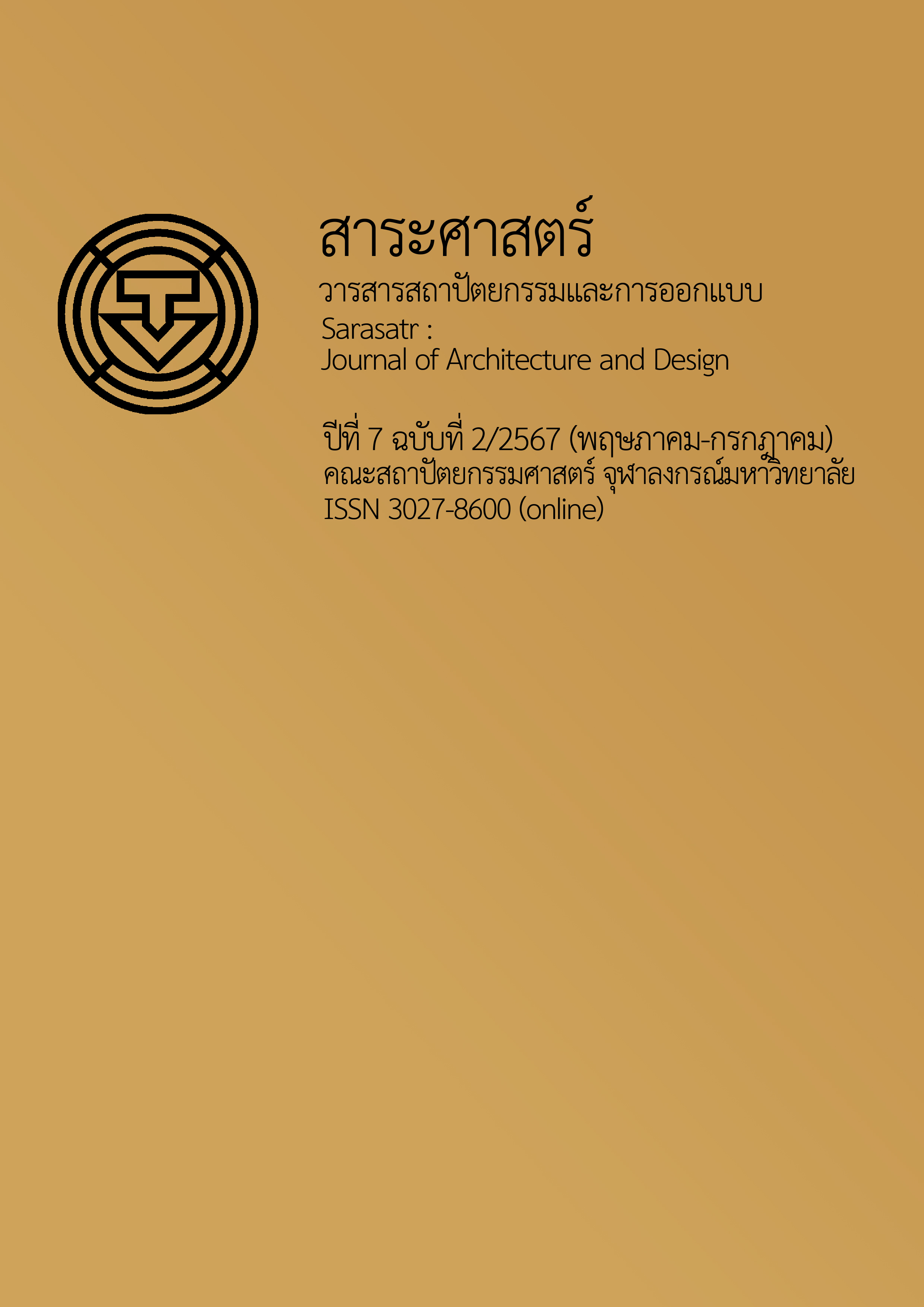The Status of Thai Muslim Houses in the Ban Krua Community
Main Article Content
Abstract
Ban krua community is a large and old Muslim community in Bangkok. Its history is dated back since the reign of King Rama I, who gave a piece of land which has become Ban Kura community now to Cham Muslims as the reward for their military service during the 1785 Burmese-Siamese War (also known as the Nine Armies’ War). As the time progressed on to the present day, ban Kura has developed into a high-density community, the forms and styles of the houses vary, however there are still many original Thai-Muslim style houses left standing. With determination as a driving force, Ban Kura’s residents, receiving support from the Community Organizations Development Institute and Arsom Slip Institute of the Arts, have run a renovation project in order to conserve houses in a selected zone within the community. Moreover, as the community residents as well as their networks want to discover opportunities and limitations in the fore-mentioned conservation effort, this article therefore has the main objective in studying current condition of the old Thai-Muslim style houses using research methods of community exploration, interviews with Ban Kura’s residents, and focus groups with the key emphasis on the samples of five houses which have been built in different periods of time from the reigns of King Rama I to King Rama VII.
The study’s result shows these houses still have structures that remain intact, roofing materials have significantly degraded while the floor and wall are still in use condition. However, sculptured wooden decorations, a key characteristic of Thai-Muslim style houses, have essentially deteriorated. Most of the owners of these houses are jobless elderly while others have unstable sources of income. As a result, although they have desire to conserve and rehabilitate the houses, their lack of finance, conservation knowledge, and conservation materials made the conservation effort on their own impossible. From the literature review, it is found that in order for the conservation effort to gain success, it requires the community residents to lead initiative in asking for the support from the related governmental agencies, for instance the Community Organizations Development Institute or the National Housing Authority etc., as well as the private sectors that can provide construction materials. Such coordination must come along with equal participation in the planning process.
Article Details
References
เขต รัตนจรณะ, เต็มดวง เศวตจินดา, ระวีวรรณ ชอุ่มพฤกษ์, และกุศล น่าคะชาต. (2537). เรือนไทยมุสลิมในจังหวัดชายแดนภาคใต้. อมรินทร์.
ดวงมาลย์ สินธุวนิช, วิสุพิทย์พร บุนนาค, เศกสิทธิ์ ภู่คำมี, สุกัลยา ปัณฑะจักร์, และมัณฑนา ศิริวรรณ. (2555). การอนุรักษ์สิ่งแวดล้อมศิลปกรรม ประเภทย่านชุมชนเก่า. สํานักงานนโยบายและแผนทรัพยากรธรรมชาติและสิ่งแวดล้อม.
ปรานอม ต้นสุขานันท์. (2559). การอนุรักษ์ชุมชนเมือง. สำนักพิมพ์แห่งจุฬาลงกรณ์มหาวิทยาลัย.
ปิ่นรัชฎ์ กาญจนัษฐิติ. (2552). การอนุรักษ์มรดกสถาปัตยกรรมและชุมชน. ภาควิชาสถาปัตยกรรมศาสตร์ คณะสถาปัตยกรรมศาสตร์ จุฬาลงกรณ์มหาวิทยาลัย
"มะจิซึคึริ" การปลุกชุมชนในญี่ปุ่น แนวความคิดและแนวทางปฏิบัติ. (2546). ภาควิชาสถาปัตยกรรมศาสตร์ คณะสถาปัตยกรรมศาสตร์ จุฬาลงกรณ์มหาวิทยาลัย.
ยงธนิศร์ พิมลเสถียร. (2556). การปรับปรุงฟื้นฟูเมืองและการอนุรักษ์เมือง. โรงพิมพ์แห่งมหาวิทยาลัยธรรมศาสตร์,
วิรุจ ถิ่นนคร. (2562). การประเมินคุณค่าสถาปัตยกรรมพื้นถิ่นในพื้นที่เมืองเก่า : กรณีศึกษา ชุมชนเมืองเก่านครศรีธรรมราช [วิทยานิพนธ์ปริญญาดุษฎีบัณฑิต ไม่ได้ตีพิมพ์]. มหาวิทยาลัยศิลปากร.
วิวัฒน์ เตมียพันธ์. (2559). สถาปัตยกรรมพื้นถิ่น : รวมบทความวิชาการในสถาปัตยกรรมพื้นถิ่น. บริษัท ทริปเพิ้ล กรุ๊ป จำกัด.
สรยุทธ ชื่นภักดี. (2550, มกราคม-มิถุนายน). ไทยมุสลิมเชื้อสายจาม. วารสารอักษรศาสตร์ (ฉบับแขกไทยแซกเทศ ข้ามเขต ความรู้), 3(1), 112-127.
อารยา ศานติสรร, ประวุฒิ แย้มยลงาม, ฐิติวุฒิ ชัยสวัสดิ์อารี, ศนิ ลิ้มทองสกุล, และวุฒิพงษ์ ทวีวงศ์. (2548). เรือนพื้นถิ่นไทย-มุสลิม 4 จังหวัดภาคใต้ : ภูมิปัญญาพัฒนาการ และความสัมพันธ์ระหว่างกันของเรือนพื้นถิ่นไทย-ไท. การประชุมทางวิชาการของมหาวิทยาลัยเกษตรศาสตร์ ครั้งที่ 43 (น.402-409). คณะสถาปัตยกรรมศาสตร์ มหาวิทยาลัยเกษตรศาสตร์.
Australia ICOMOS. (2013). The Burra Charter: The Australia ICOMOS charter for places of cultural significance, 2013. Australia ICOMOS-International Council on Monuments and Sites.
Douglas, J. (2002). Building adaptation. Butterworth-Heineman.
Feilden, B. M. (1995). Conservation of historic buildings. Butterworth-Heinemann.
Grimmer, A. E. (2017). The secretary of the interior’s standards. National Park Service, U.S. Department of the Interior.
ICOMOS. (1999). Charter on the built vernacular heritage (1999). https://www.icomos.org/images/DOCUMENTS/Charters/vernacular_e.pdf
Jokilehto, J. A. (2002). History of architectural conservation. Butterworth Heinemann.
National Heritage Memorial Fund Heritage Lottery Fund. (1998). Lottery distribution account 1998-99. The Stationery Office.


